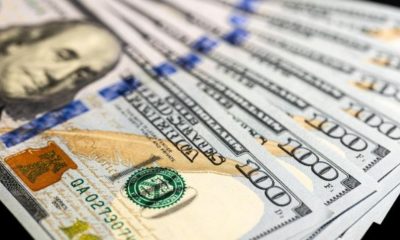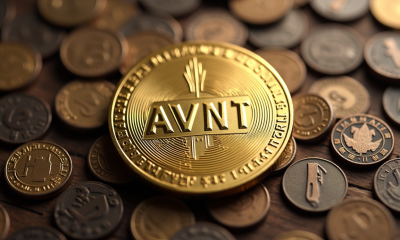

others
Gold keeps the red amid resurgent USD demand; holds above $3,300 mark – Crypto News
- Gold price drops to a multi-day low on Monday amid modest USD strength.
- Fed rate cut bets and US fiscal concerns should act as a headwind for the USD.
- Geopolitical risks could further offer support to the safe-haven precious metal.
Gold price (XAU/USD) retains intraday bearish bias through the first half of the European session, though it manages to bounce off the $3,300 mark, or a one-week low touched this Monday. A goodish pickup in the US Dollar (USD) demand turns out to be a key factor driving flows away from the commodity. However, the growing acceptance that the US Federal Reserve (Fed) will lower borrowing costs further this year might hold back the USD bulls from placing aggressive bets and lend some support to the non-yielding yellow metal.
Furthermore, concerns that US President Donald Trump’s massive tax-cut and spending bill would worsen America’s long-term debt problems might contribute to capping gains for the USD. Meanwhile, the market sentiment remains fragile on the back of the uncertainty surrounding US President Donald Trump’s erratic trade policies. Apart from this, fresh Israeli strikes on Yemen in almost a month temper investors’ appetite for riskier assets, which further helps limit the downside for the safe-haven Gold price and warrants caution for bears.
Daily Digest Market Movers: Gold price continues to be weighed down by notable USD strength
- The US Dollar kicks off the new week on a slightly positive note and weighs on the Gold price, though the downside potential seems limited amid a combination of supporting factors.
- US President Donald Trump’s ‘One Big Beautiful Bill’ is now a law and is expected to add $3.4 trillion to the nation’s debt over the next decade, worsening the long-term debt problem.
- This comes amid worries about the potential economic fallout from Trump’s reciprocal tariffs and dovish Federal Reserve bets, which should keep a lid on any meaningful USD strength.
- Trump said on his social media early this Monday that the US tariff letters, and/or deals, with various countries from around the world, will be delivered starting 12:00 P.M. on July 7th.
- Trump followed up with a warning, stating that any country aligning with the anti-American policies of BRICS will be charged an additional 10% tariff and there will be no exceptions to this policy.
- Traders are currently pricing in over a 70% chance that the US central bank would lower borrowing costs in September and deliver at least two 25 basis points rate reductions by the year-end.
- The Israeli military carried out intense strikes on Houthi targets in three Yemeni ports and a power plant early this Monday in response to repeated attacks by the Iran-aligned group on Israel.
- This keeps geopolitical risks in play and should offer some support to the safe-haven precious metal. Traders now look to the release of FOMC minutes on Wednesday for a fresh impetus.
Gold price bears await sustained break below $3,300 mark before positioning for deeper losses
The recent repeated failures to build on momentum beyond the 100-period Simple Moving Average (SMA) on the 4-hour chart and the subsequent fall below the $3,300 mark will be seen as a fresh trigger for the XAU/USD bears. Given that oscillators on the daily chart have just started gaining negative traction, the Gold price might then accelerate the slide to the next relevant support near the $3,270 horizontal zone en route to the $3,248-3,248 region.
On the flip side, the $3,324-3,325 region now seems to act as an immediate hurdle ahead of the $3,342-3,343 zone. Some follow-through buying, leading to a further strength beyond the $3,352-3,355 area, could provide a goodish lift to the Gold price and allow bulls to aim towards reclaiming the $3,400 round figure.
US Dollar FAQs
The US Dollar (USD) is the official currency of the United States of America, and the ‘de facto’ currency of a significant number of other countries where it is found in circulation alongside local notes. It is the most heavily traded currency in the world, accounting for over 88% of all global foreign exchange turnover, or an average of $6.6 trillion in transactions per day, according to data from 2022.
Following the second world war, the USD took over from the British Pound as the world’s reserve currency. For most of its history, the US Dollar was backed by Gold, until the Bretton Woods Agreement in 1971 when the Gold Standard went away.
The most important single factor impacting on the value of the US Dollar is monetary policy, which is shaped by the Federal Reserve (Fed). The Fed has two mandates: to achieve price stability (control inflation) and foster full employment. Its primary tool to achieve these two goals is by adjusting interest rates.
When prices are rising too quickly and inflation is above the Fed’s 2% target, the Fed will raise rates, which helps the USD value. When inflation falls below 2% or the Unemployment Rate is too high, the Fed may lower interest rates, which weighs on the Greenback.
In extreme situations, the Federal Reserve can also print more Dollars and enact quantitative easing (QE). QE is the process by which the Fed substantially increases the flow of credit in a stuck financial system.
It is a non-standard policy measure used when credit has dried up because banks will not lend to each other (out of the fear of counterparty default). It is a last resort when simply lowering interest rates is unlikely to achieve the necessary result. It was the Fed’s weapon of choice to combat the credit crunch that occurred during the Great Financial Crisis in 2008. It involves the Fed printing more Dollars and using them to buy US government bonds predominantly from financial institutions. QE usually leads to a weaker US Dollar.
Quantitative tightening (QT) is the reverse process whereby the Federal Reserve stops buying bonds from financial institutions and does not reinvest the principal from the bonds it holds maturing in new purchases. It is usually positive for the US Dollar.
-

 Blockchain1 week ago
Blockchain1 week agoTokenized Deposits for Payments, Treasury – Crypto News
-

 Metaverse1 week ago
Metaverse1 week agoTech layoffs: From Meta, Amazon to Google — these IT majors have cut AI related jobs – Crypto News
-
Business1 week ago
XRP Price Classical Pattern Points to a Rebound as XRPR ETF Hits $100M Milestone – Crypto News
-
Technology1 week ago
$1.68 Trillion T. Rowe Price Files for First Active Crypto ETF Holding BTC, ETH, SOL, and XRP – Crypto News
-
Cryptocurrency1 week ago
Robinhood Lists HYPE As Hyperliquid Flips Aster, Lighter In Perp DEX Volume – Crypto News
-

 Metaverse1 week ago
Metaverse1 week agoBezos fund believes AI can save the planet. Nvidia, Google are all-in. – Crypto News
-

 Cryptocurrency1 week ago
Cryptocurrency1 week agoCrypto update: Bitcoin and Ethereum are stable as market’s focus shifts to US inflation data – Crypto News
-
Cryptocurrency1 week ago
XRP News: Ripple Unveils ‘Ripple Prime’ After Closing $1.25B Hidden Road Deal – Crypto News
-

 Cryptocurrency1 week ago
Cryptocurrency1 week agoTrump plans to pick Michael Selig to lead CFTC: Report – Crypto News
-
Business7 days ago
White House Crypto Czar Backs Michael Selig as ‘Excellent Choice’ To Lead CFTC – Crypto News
-

 Blockchain6 days ago
Blockchain6 days agoBinance Stablecoin Outflow On A Steady Rise — What This Means For The Market – Crypto News
-

 Blockchain1 week ago
Blockchain1 week agoHere’s Why The Shiba Inu Price Could Bottom And Rise Another 40% – Crypto News
-

 Technology1 week ago
Technology1 week agoChatGPT down: Thousands of users unable to access AI chatbot, OpenAI says it is working on a fix – Crypto News
-
Business1 week ago
Breaking: Trump To Meet China’s President On October 30, Bitcoin Bounces – Crypto News
-

 Blockchain7 days ago
Blockchain7 days agoAfrica Countries Pass Crypto Laws to Attract Industry – Crypto News
-
others6 days ago
JPY soft and underperforming G10 in quiet trade – Scotiabank – Crypto News
-

 De-fi6 days ago
De-fi6 days agoNearly Half of US Retail Crypto Holders Haven’t Earned Yield: MoreMarkets – Crypto News
-

 Cryptocurrency5 days ago
Cryptocurrency5 days agoUSDJPY Forecast: The Dollar’s Winning Streak Why New Highs Could Be At Hand – Crypto News
-
Business1 week ago
How the Crypto Market Could React to the Next Fed Meeting on October 29? – Crypto News
-

 Cryptocurrency1 week ago
Cryptocurrency1 week ago155 Filings Across 35 Assets, Analyst Backs Index Funds – Crypto News
-

 Technology1 week ago
Technology1 week agoSundar Pichai hails ‘verifiable’ quantum computing breakthrough as Google’s Willow surpasses ability of supercomputers – Crypto News
-

 Technology1 week ago
Technology1 week ago‘It just freezes’: Spotify users fume over app crashes on Android devices, company responds – Crypto News
-
others1 week ago
JPY weak and underperforming – Scotiabank – Crypto News
-

 Cryptocurrency1 week ago
Cryptocurrency1 week agoDOGE to $0.33 in Sight? Dogecoin Must Defend This Key Level First – Crypto News
-

 Blockchain7 days ago
Blockchain7 days agoISM Data Hints Bitcoin Cycle Could Last Longer Than Usual – Crypto News
-

 Technology6 days ago
Technology6 days agoNothing OS 4.0 Beta introduces pre-installed apps to Phone (3a) series: Co-founder Akis Evangelidis explains the update – Crypto News
-

 Blockchain6 days ago
Blockchain6 days agoEntire Startup Lifecycle to Move Onchain – Crypto News
-

 De-fi6 days ago
De-fi6 days agoHYPE Jumps 10% as Robinhood Announces Spot Listing – Crypto News
-

 Blockchain6 days ago
Blockchain6 days agoEthereum Rebounds From Bull Market Support: Can It Conquer The ‘Golden Pocket’ Next? – Crypto News
-
others6 days ago
Platinum price recovers from setback – Commerzbank – Crypto News
-

 Blockchain5 days ago
Blockchain5 days agoXRP/BTC Retests 6-Year Breakout Trendline, Analyst Calls For Decoupling – Crypto News
-

 Technology5 days ago
Technology5 days agoSurvival instinct? New study says some leading AI models won’t let themselves be shut down – Crypto News
-

 Cryptocurrency5 days ago
Cryptocurrency5 days agoWestern Union eyes stablecoin rails in pursuit of a ‘super app’ vision – Crypto News
-

 Blockchain5 days ago
Blockchain5 days agoXRP Price Gains Traction — Buyers Pile In Ahead Of Key Technical Breakout – Crypto News
-

 others1 week ago
others1 week agoLikely to trade in a range between 0.6470 and 0.651 – UOB Group – Crypto News
-

 Blockchain1 week ago
Blockchain1 week agoBinance expands global crypto access with new USD transfer feature – Crypto News
-

 Blockchain1 week ago
Blockchain1 week agoKadena Shuts Down Operations – Team Confirms Immediate Cease Of All Activities – Crypto News
-

 Technology1 week ago
Technology1 week agoYouTube brings a new feature to stop you from endlessly scrolling Shorts: here’s how it works – Crypto News
-

 Technology1 week ago
Technology1 week agoSolana’s RWA market surpasses $700M all-time high as adoption accelerates – Crypto News
-

 Cryptocurrency1 week ago
Cryptocurrency1 week agoJito’s JTO token rises on a16z’s $50 million investment in Solana staking protocol – Crypto News
-
Technology1 week ago
Dogecoin Price Crash Looms as Flag, Death Cross, Falling DOGE ETF Inflows Coincide – Crypto News
-

 De-fi1 week ago
De-fi1 week agoSolana DEX Meteora Launches Native MET Token – Crypto News
-

 Technology1 week ago
Technology1 week agoGoogle and Apple face extra UK scrutiny over strategic role in mobile platforms – Crypto News
-

 Cryptocurrency1 week ago
Cryptocurrency1 week agoLedger Nano Gen5 feels like Flex for less – Crypto News
-

 De-fi1 week ago
De-fi1 week agoAster Rallies on ‘Rocket Launch’ Incentives Campaign – Crypto News
-

 Blockchain1 week ago
Blockchain1 week agoBitcoin Whale From 2009 Moves Coins After 14 Years Asleep – Crypto News
-

 Cryptocurrency1 week ago
Cryptocurrency1 week agoFetch.ai and Ocean Protocol move toward resolving $120M FET dispute – Crypto News
-

 Technology1 week ago
Technology1 week agoOpenAI announces major Sora update: Editing, trending cameos, and Android launch on the way – Crypto News
-
Business1 week ago
HBAR Price Targets 50% Jump as Hedera Unleashes Massive Staking Move – Crypto News
-

 Cryptocurrency1 week ago
Cryptocurrency1 week agoWhat next for Avantis price after the 73% recovery? – Crypto News






